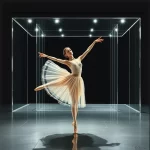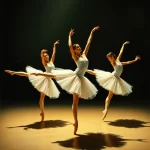Ballet: Glass Pieces (Philip Glass, 1983)

Introduction
Ballet: Glass Pieces, choreographed by Jerome Robbins and set to the music of Philip Glass, premiered in 1983. This ballet is a modern, abstract work that explores the interplay between movement and music, devoid of a traditional narrative. Instead, it focuses on the rhythmic and repetitive structures of Glass’s compositions, creating a mesmerizing and dynamic experience for the audience.
Historical Background
Creation and Development
Glass Pieces was created during a period when both Jerome Robbins and Philip Glass were exploring new artistic territories. The early 1980s were marked by a resurgence of interest in minimalism in various art forms, and Glass was at the forefront of this movement in music. His compositions, characterized by repetitive structures and evolving patterns, provided a fresh canvas for choreographers.
Robbins, a celebrated choreographer known for his work in both ballet and Broadway, was inspired by the energy and structure of Glass’s music. The collaboration between Robbins and Glass was a meeting of two creative minds from different artistic backgrounds, resulting in a ballet that broke away from traditional storytelling and focused on pure movement and rhythm.
Premiere and Reception
Glass Pieces premiered on May 12, 1983, at the New York State Theater, performed by the New York City Ballet. The initial reception was overwhelmingly positive, with critics praising the innovative choreography and the seamless integration of Glass’s music. The ballet was noted for its modernity and its ability to captivate audiences without relying on a conventional plot.
Notable early performances included revivals by the New York City Ballet and other major companies, cementing Glass Pieces as a significant work in the contemporary ballet repertoire.
Synopsis of the Ballet
Glass Pieces is a one-act ballet divided into three distinct sections, each set to different compositions by Philip Glass. The ballet does not follow a traditional narrative but instead focuses on the interaction between the dancers and the music.
Section I: Rubric
The first section, set to “Rubric” from Glass’s album “Glassworks,” features a large ensemble of dancers moving in intricate patterns. The choreography emphasizes the repetitive and rhythmic nature of the music, with dancers weaving in and out of formations, creating a sense of constant motion.
Section II: Facades
The second section, set to “Facades” from the same album, is more introspective and features a smaller group of dancers. The choreography is more lyrical, with fluid movements that reflect the haunting quality of the music. This section often includes a pas de deux, highlighting the emotional depth of the piece.
Section III: Akhnaten
The final section is set to excerpts from Glass’s opera “Akhnaten.” This part of the ballet is the most dynamic, with a large ensemble performing vigorous and athletic movements. The choreography mirrors the driving rhythms and intensity of the music, bringing the ballet to a powerful conclusion.
Musical Composition
Composer’s Role
Philip Glass, a pioneer of minimalism, composed the music for Glass Pieces. His work is characterized by repetitive structures, evolving patterns, and a focus on rhythm and texture. Glass’s compositions for this ballet provide a rich and complex musical landscape that complements Robbins’s choreography.
Notable pieces within the score include “Rubric,” “Facades,” and excerpts from “Akhnaten,” each contributing to the distinct sections of the ballet.
Musical Themes and Motifs
Glass’s music for Glass Pieces features recurring themes and motifs that enhance the ballet’s structure and emotional impact. The repetitive patterns create a hypnotic effect, drawing the audience into the rhythm of the dance. The music’s evolving nature mirrors the choreography’s fluidity and complexity, creating a seamless integration of sound and movement.
Famous Recordings and Performances
Several recordings of Glass’s music for Glass Pieces are available, including performances by the Philip Glass Ensemble and other orchestras. These recordings capture the intricate details and dynamic energy of the compositions, providing an excellent accompaniment to the ballet.
Choreography and Dance
Choreographer’s Vision
Jerome Robbins’s vision for Glass Pieces was to create a ballet that emphasized movement and rhythm over narrative. His choreography is marked by its precision, complexity, and innovation. Robbins’s ability to translate the repetitive structures of Glass’s music into dynamic and engaging dance movements is a testament to his creative genius.
Signature Dance Numbers
Key dance numbers in Glass Pieces include the ensemble sections in “Rubric,” the pas de deux in “Facades,” and the vigorous group dances in “Akhnaten.” Each of these numbers showcases Robbins’s ability to create intricate patterns and formations that reflect the music’s structure and energy.
Notable Interpretations
Over the years, different productions of Glass Pieces have brought unique interpretations to the choreography. Some have emphasized the ballet’s modernity and abstract nature, while others have focused on the emotional depth of the music and dance. Notable interpretations include performances by the New York City Ballet, the Paris Opera Ballet, and other major companies.
Characters and Roles
Main Characters
Glass Pieces does not feature traditional characters or a narrative. Instead, the dancers themselves become the focal point, with their movements and interactions creating the ballet’s structure and emotional impact.
Supporting Characters
As with the main characters, the supporting roles in Glass Pieces are defined by the dancers’ movements and formations. The ensemble plays a crucial role in creating the intricate patterns and rhythms that characterize the ballet.
Famous Dancers
Notable dancers who have performed in Glass Pieces include members of the New York City Ballet, such as Wendy Whelan, Damian Woetzel, and Maria Kowroski. Their performances have been praised for their precision, energy, and emotional depth.
Cultural and Artistic Impact
Influence on Ballet and Dance
Glass Pieces has had a significant impact on contemporary ballet and dance. Its innovative use of minimalism and abstract choreography has influenced other choreographers and works. The ballet’s emphasis on movement and rhythm over narrative has opened new possibilities for dance as an art form.
Cultural Significance
Glass Pieces holds a unique place in popular culture and the arts. Its collaboration between two leading figures in music and dance has been celebrated as a landmark in contemporary art. The ballet has been referenced in various media and has inspired adaptations in film, theater, and other art forms.
Legacy and Revivals
Glass Pieces continues to be performed and celebrated today. Major revivals by companies such as the New York City Ballet and the Paris Opera Ballet have kept the ballet alive for new generations of audiences. Its legacy as a groundbreaking work in contemporary ballet remains strong.
Iconic Productions
Historic Productions
The original production of Glass Pieces by the New York City Ballet in 1983 is considered iconic. Key figures involved included Jerome Robbins as choreographer, Philip Glass as composer, and dancers such as Wendy Whelan and Damian Woetzel.
Contemporary Productions
Recent productions of Glass Pieces have brought new interpretations and innovations to the ballet. Companies such as the Paris Opera Ballet and the San Francisco Ballet have staged contemporary versions that highlight the ballet’s timeless appeal and modern relevance.
Production Design
The production design for Glass Pieces has evolved over the years, with different companies bringing their unique visions to the ballet. Set, costume, and lighting design play crucial roles in creating the ballet’s atmosphere and enhancing its visual impact. Notable designs include minimalist sets and costumes that reflect the abstract nature of the choreography.
Critical Reception and Reviews
Initial Critical Response
The initial critical response to Glass Pieces was overwhelmingly positive. Critics praised the innovative choreography, the seamless integration of Glass’s music, and the dynamic performances by the dancers. The ballet was hailed as a groundbreaking work in contemporary dance.
Modern Reviews
Contemporary reviews of Glass Pieces continue to be positive, with critics and audiences appreciating its modernity, complexity, and emotional depth. The ballet remains relevant and popular, with new productions and revivals keeping it fresh and engaging for today’s audiences.
Fun Facts and Trivia
Behind-the-Scenes Stories
One interesting behind-the-scenes story involves the collaboration between Robbins and Glass. Despite their different artistic backgrounds, the two found common ground in their desire to create something new and innovative. Their collaboration was marked by mutual respect and a shared vision for the ballet.
Notable Performers
Famous dancers associated with Glass Pieces include Wendy Whelan, Damian Woetzel, and Maria Kowroski. Their performances have been celebrated for their precision, energy, and emotional depth.
Trivia
- Glass Pieces was one of the first ballets to feature music by Philip Glass, a pioneer of minimalism.
- The ballet’s premiere in 1983 marked a significant moment in contemporary dance, bringing together two leading figures in music and choreography.
- Glass Pieces has been performed by major ballet companies around the world, including the New York City Ballet, the Paris Opera Ballet, and the San Francisco Ballet.
Conclusion
Summary of the Ballet’s Importance
Glass Pieces is a significant work in the world of dance, known for its innovative choreography, seamless integration of music and movement, and its impact on contemporary ballet. The collaboration between Jerome Robbins and Philip Glass resulted in a ballet that continues to captivate audiences and inspire new generations of dancers and choreographers.
Final Thoughts
Glass Pieces remains a timeless and relevant work in the world of dance. Its emphasis on movement and rhythm over narrative, combined with the innovative use of minimalism, makes it a unique and powerful experience for audiences. Whether you are a seasoned ballet enthusiast or new to the art form, Glass Pieces is a must-see performance that showcases the best of contemporary dance.
FAQ
What is the central theme of this ballet?
The central theme of Glass Pieces is the interplay between movement and music, focusing on rhythm and structure rather than a traditional narrative.
Who are the main characters in this ballet?
Glass Pieces does not feature traditional characters. Instead, the dancers themselves become the focal point, with their movements creating the ballet’s structure and emotional impact.
What is the most famous dance number in this ballet?
One of the most famous dance numbers in Glass Pieces is the ensemble section in “Rubric,” known for its intricate patterns and dynamic energy.
How long does a typical performance of this ballet last?
A typical performance of Glass Pieces lasts approximately 30-40 minutes, as it is a one-act ballet divided into three sections.
Are there any modern adaptations of this ballet?
Yes, there have been several modern adaptations and revivals of Glass Pieces by major ballet companies around the world, each bringing unique interpretations to the choreography.
Why is this ballet considered important in the history of dance?
Glass Pieces is considered important in the history of dance for its innovative use of minimalism, its emphasis on movement and rhythm over narrative, and its impact on contemporary ballet. The collaboration between Jerome Robbins and Philip Glass resulted in a groundbreaking work that continues to inspire and captivate audiences.





